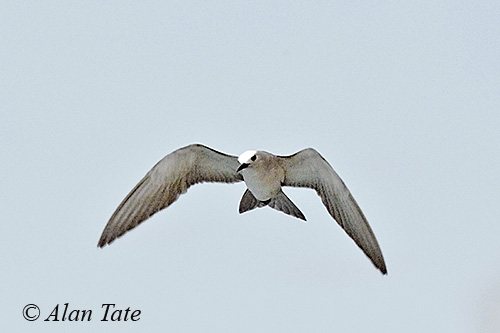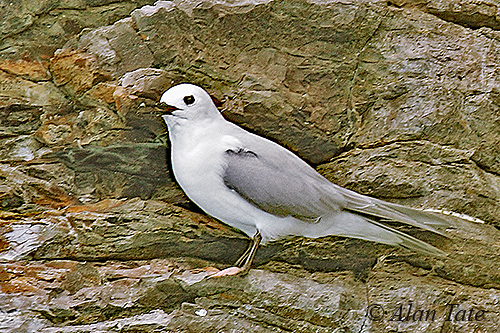
Fr: Noddi gris
Ang: Grey Noddy
All: Graunoddi
Esp: Tiñosa Gris
Ita: Noddy grigio
Nd: Grijze Noddy
Sd: blek noddy
Photographers:
Alan & Ann Tate
AA Bird Photography
Text by Nicole Bouglouan
Sources:
HANDBOOK OF THE BIRDS OF THE WORLD Vol 3 by Josep del Hoyo-Andrew Elliott-Jordi Sargatal - Lynx Edicions - ISBN: 8487334202
Te Ara – The Encyclopedia of New Zealand
Wikipedia, the free encyclopaedia
Grey Noddy
Anous albivitta
Charadriiformes Order – Laridae Family
INTRODUCTION:
The Grey Noddy is found in subtropical and warm temperate waters of the South Pacific Ocean.
This species breeds on rocky islands and nests on cliffs or on the ground. It forages in inshore waters, feeding on small crustaceans, fish and squid. During the nesting period, both parents share the nesting duties.
The Grey Noddy was first described in 1856 by the French ornithologist Charles Lucien Bonaparte, and was named Procelsterna albivitta. In 2016, the five Noddy species were merged into a single genus “Anous”.
The Grey Noddy is not globally threatened at the moment, and the population trend is stable.
DESCRIPTION OF THE BIRD:
Biometrics:
Length: 28-31 cm
Wingspan: 46-60 cm
Weight: 45-70 g
The Grey Noddy has pale blue-grey upperparts with paler head and neck, and off-white underparts.
On the upperparts, the wings are slightly darker than the rest of the body. The coverts are greyer or tinged brown, and the outer flight-feathers are blackish. The dark grey tail is short and forked.
On the underparts, the underwing-coverts are pale or white, whereas primaries and secondaries are darker.

On the white head, the bill is black.
The dark brown eyes show a distinctive eyering with two parts, a small black patch in front and a broken white eyering in back.
The legs are relatively long. Both legs and large feet are black with pale pink webs.
Male and female are similar.
The juvenile resembles adults, but upperparts and crown are brownish.
SUBSPECIES AND RANGE:
The Grey Noddy was formerly regarded as a pale morph of the Blue Noddy (Anous cerulea), but today, it is considered to be a separate species with three subspecies that differ mainly in plumage tone.
A.a. albivitta (described above) is found in Lord Howe Island, Norfolk Island, New Zealand (islands of NW and N North Island, Kermadec Islands) and Tonga.
A.a. skottsbergii is found on Henderson Island (in Pitcairn Island), Easter Island and Salas y Gomez Islands (off NW Chile).
This race has whitest underparts.
A.a. imitatrix breeds on San Ambrosio and San Felix (Desventuradas Islands) off N Chile.
This race has also whitest underparts.
HABITAT:
The Grey Noddy breeds on rocky islands and forages and feeds in shallow water, usually around the coasts of the breeding islands.
The cliffs are also used as roosting sites, usually more often than areas of sheltered rocky ground, beaches or bushy vegetation.
Flocks can be seen feeding over lagoons and inshore waters, and often over upwelling currents.
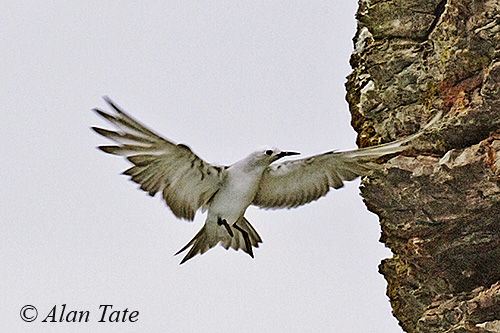
CALLS AND SONGS: SOUNDS BY XENO-CANTO
The Grey Noddy is usually silent, but it becomes noisier around the colonies. We can hear screams “kraarr”, also a low-pitched sound given both in flight and on the ground. These noisy screams are given when the flocks are disturbed.
We can also hear a continuous, soft, purring call “cror-r-r-r” while the birds are perched on rocks.
BEHAVIOUR IN THE WILD:
The Grey Noddy feeds on small crustaceans, sea-striders (Halobates), small fish and squid.
The prey are caught while the bird is hovering near the water surface. Because the Grey Noddy has the narrowest gape of all Laridae species, it takes the smallest fish (average size about 17 mm).
While fluttering or hovering low over water, the Grey Noddy dips repeatedly to catch prey. It is often observed face upwind.
The Grey Noddy gathers in large feeding flocks up to thousands of individuals. They are usually gregarious.
The Grey Noddy establishes loose breeding colonies on rocky islands. The nest is placed in a sheltered rocky surface or protected by vegetation. Both adults share the nesting duties.
Some courtship displays have been described as complex aerial displays, with one bird hovering in the wind and weaving across the flight path of the other one.
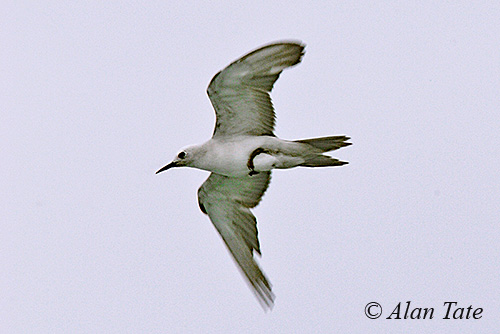
The Grey Noddy is a non-migratory species, but it usually disperses around the breeding colonies. It rarely reaches the continental waters.
It is described as uncommon visitor to N New Zealand, and flocks of about 1,000 individuals were reported in January 1970.
Non-breeder birds wander in many areas of the South Pacific Ocean.
While foraging, the Grey Noddy flies low over the water. It performs quick, shallow wingbeats and often dips to catch a prey at water surface.
The flight is usually graceful and floating, often described as deep-winged, floating, leisurely flight.
REPRODUCTION OF THIS SPECIES:
The breeding season takes place between August and November in SW Pacific Ocean for the nominate race.
The race “skottsbergii” is present in December (April and in August on Easter Island where it was found nesting in June). It is also reported breeding on Pitcairn Island in October.
The race “imitatrix” is found on San Ambrosio Island in October.
The Grey Noddy forms loose colonies on rocky islands. The nest is placed on cliff, in crevice or ledge, up to 600 metres high, or on the ground under rocks or protected by tussock grass, or also on the bare rock. The nest is made of grass and seaweeds.
The female lays a single, oval-shaped, small egg. It is creamy-white with brown and grey markings. The incubation lasts 32 days, shared by both adults.
At hatching, the chick has pale brownish down overall. The bill is black. The eye shows a whitish upper eyelid. The down becomes paler as the chick is growing.
After hatching, the chick is brooded continuously for the first 2-3 weeks. It fledges about 35-37 days after hatching. Both parents continue feeding it by regurgitation for some time.
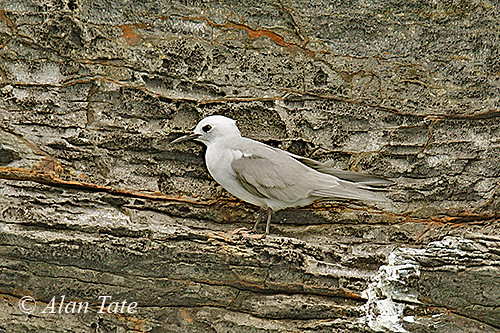
Unlike other Laridae species, the chick begs food by pecking at the pink webs on adult feet, rather than at the bill.
During the incubation, the partner of the incubating adult may display in front of the nest, hovering with wings and tail raised at a 45° angle, and also performing series of U-shaped dipping flights.
PROTECTION / THREATS / STATUS:
The Grey Noddy is generally not globally threatened, except on Easter Island where cats (Felis catus) are the main predators of the species.
The status of this species are poorly known and the population is probably under 25,000 pairs, mainly of the nominate race in SW Pacific Ocean.
The two SE Pacific Ocean populations including the two other subspecies are probably endangered.
However, the overall population trend appears to be stable, and the Grey Noddy is currently evaluated as Least Concern.
